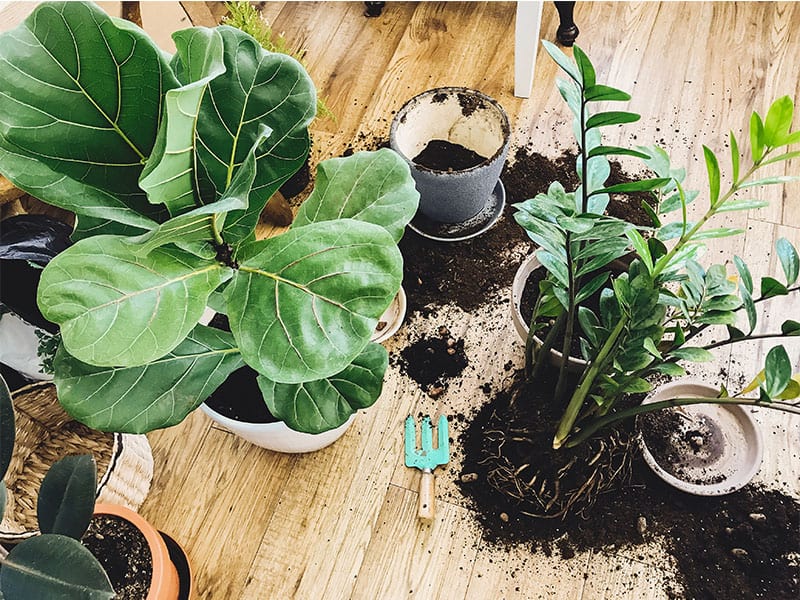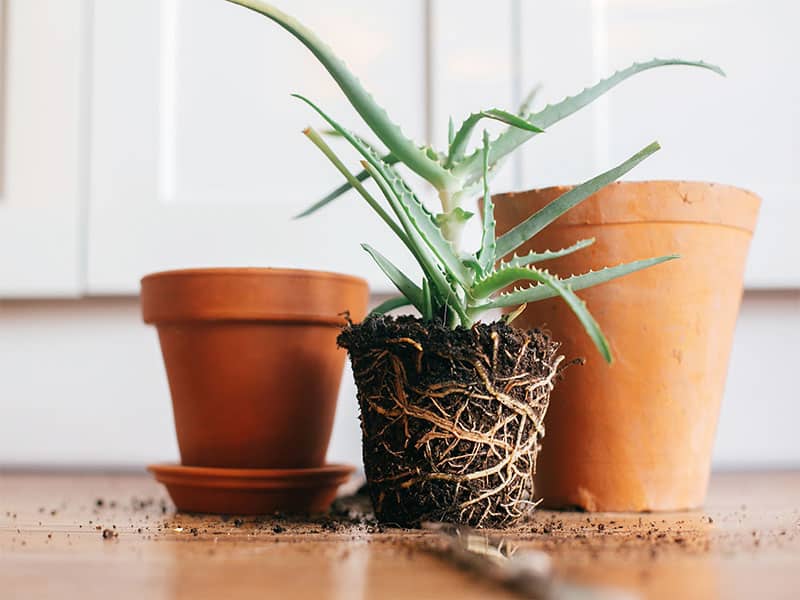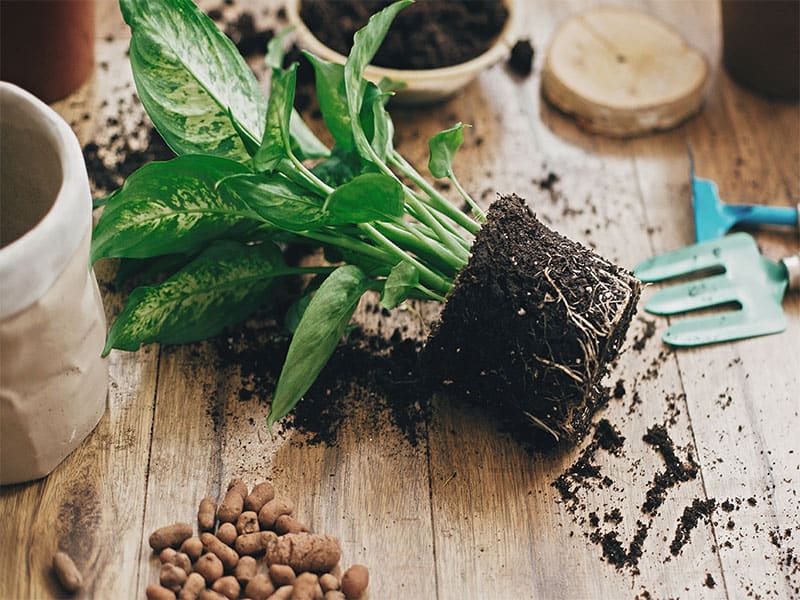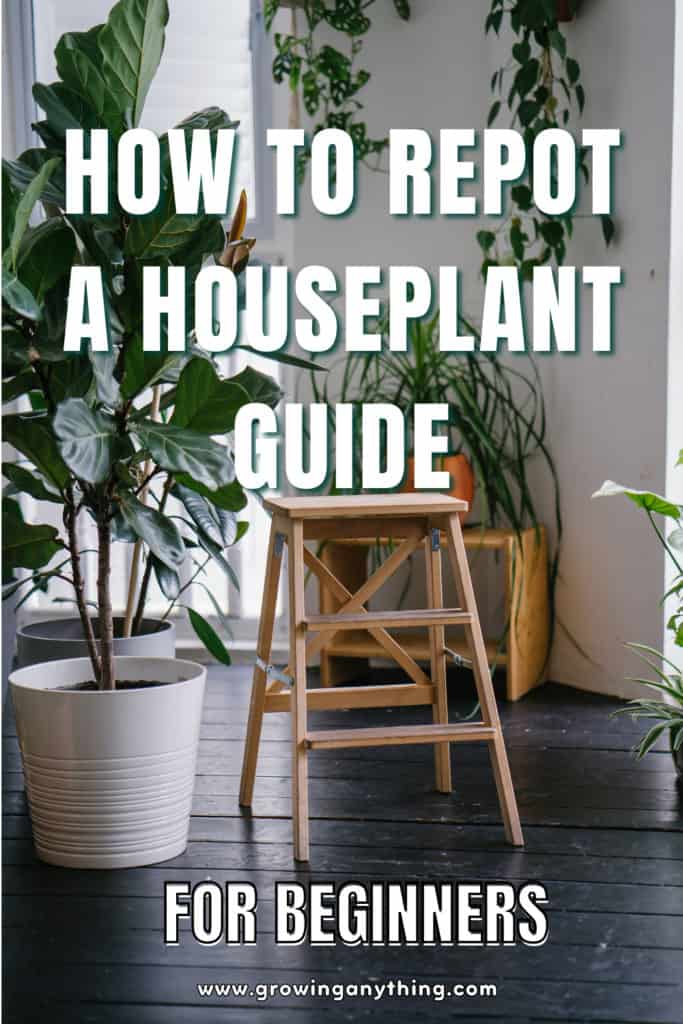How to Repot a Houseplant
If you have gotten into the craze for houseplants, one of the first things that you will need to learn about your plant is when and how you should repot it. Plants are very beneficial for people – they help us stay connected to nature even when we are bound to our work desks or homes.
Once you add a few houseplants around, the thing that you need to learn is how to take proper care of them so you can have them around for a long time. It is not only about the watering and about pruning – plants sometimes need a change of soil or pot.
If you want to learn how to repot your houseplant quickly and easily, stay tuned and I will cover all of the facts that you need to know. With this guide, you will feel like a professional gardener in no time!

Should You Repot a Houseplant?
Even if your houseplant is fairly new, it still might need to be repotted. Plants need to change pots every now and then, mainly because they outgrow the first pot but there are other reasons why you will need to repot a houseplant.
If you want to know whether you should repot your houseplant or not, you should look at how old the plant is. If you have had it for 18 months or more, then you will need to repot it. However, if you have had it for less than that, chances are that you can go for a few more months with the old pot.

Why Should You Repot a Houseplant?
If you are wondering whether you should repot your houseplant, you can look for signs in the plant itself that will tell you if it is time to report it or if you should wait longer. Here are the five main reasons why you should report your houseplant!
1. Fresh Soil
When plants grow, they tend to absorb all the nutrients available to them through the soil. Over time, they leave the soil completely drained of nutrients.
If you notice that your plant is still growing but showing some discoloration or general ‘unhappiness,’ that might point to the plant not having enough food to feed on. After some time, just using fertilizer will not do the trick.
This is why you should repot your plant and use new soil. It will give your plant a nutrient boost and it will keep it thriving for much longer.
2. Better Watering
There is a chance for plants to become root-bound after some time. What this means is that the plant needs new space immediately because its roots have wrapped all around the pot and are using up the water too quickly.
The water will not stay throughout the soil but go through the channels right to the bottom of the pot. Simply said, the plant will not be able to benefit from the watering at all.
If this is something that is happening to your plant, you must repot it immediately and help it come alive again.
3. Room to Grow
Sometimes, pots get too small for the plant after some time. Plants need room to grow, while they also grow quite fast.
Not only will the plant need a bigger pot, but it will also need more soil to feed on and more water. Replanting it to a bigger pot will help it grow and develop faster.
4. Disease Prevention
Root rot is a common issue that plants can face. The main reason why plants develop root rot is that they have been overwatered for some time and become unable to absorb the entire amount of water given to them.
If you want to save your plants from such diseases, you will need to remove damaged roots and give the plant new soil. From there on out, you should make sure that you do not overwater them so you will not have to go through the same process again soon.
5. Divide and Plant Babies
Once a plant becomes too big for its pot, it is not only a good idea to repot it but you should also divide it. Most plants thrive after being divided because the new stems and leaves do not take too much of their energy anymore.
When to Repot a Houseplant?
When you conclude that your houseplant needs to be repotted, you will need to learn when the repotting should take place.
It is best to repot a plant in spring when the plant is actively growing roots. It will also adjust to the new soil and pot quickly if it is planted when actively growing. So, make sure that the timing is right if you want the repotting to go as planned.
In case you do not know when exactly your plant needs repotting, these several signs will tell you if it is time.
1. You Cannot See the Pot Anymore
Some houseplants get a lot larger in the first few years of their life. This means that they can quickly outgrow the original pot in which they were planted.
If you start to see parts of the plant hanging out of the pot, it might be time for a pot change. Also, if the plant is large enough to cover the entire pot, then it is also a good time to start thinking about giving the plant a new pot.
2. The Drainage Holes Are Full
Good drainage is very important for a plant. It is not only about the rocks that you place on the bottom of the pot, it is also about the drainage holes that the pot has. They need to be open at all times!
If you see that the plant is blocking the drainage holes, this is a sign that you need to repot the plant. The water that you give your plant will only accumulate on the bottom of the pot, causing the plant to either drown because it will not get enough oxygen, or develop root rot.
Eventually, these problems could lead to the plant dying down, which means that you will have to get rid of it. If you want to keep the plant and make it thrive again, you will need to open up those drainage holes or use a larger pot for your plant.
3. The Plant Does Not Get Enough Water
There are several reasons why the plant might not be getting enough water. If you notice any water on top of flowers or leaves, while the soil seems dry, this will tell you that the plant cannot use the water in the right way.
Also, if the plant is yellowing and wilting, this is another sign that it does not get enough water. Consider repotting it and giving it some new soil as well. This will help it come alive again.
4. The Soil Needs Changing
One of the biggest problems that can arise with the soil in a pot is disintegration. If you see that the soil starts to get a bit too dry, there are two things that you can do.
You can throw out the old soil and use new in the same pot, or you can repot your plant. I already mentioned that such big changes can make the plant stress out, so make sure that you make the changes in the right way.
When Not to Repot Your Houseplant?
As important as it is to know when to repot your houseplant, you will also need to know when not to do it. Even though these rules are general and might not apply to certain plants, they will still help you to decide if the plant should or should not be repotted.
1. Do Not Repot When the Plant Is Flowering
If a plant is flowering, that means that it has all the proper conditions it needs. Shaking it around and changing up its growing conditions will not make it grow more, it will only cause it some problems.
To avoid transplant shock, wait until a time when the plant does not flower. As mentioned before, it is best to repot it in spring before its blooming period starts.
2. Do Not Repot Large Plants
If your plant is a large one and it has already reached its full size, trying to repot it might only damage it or hurt you.
In this case, you will only need to remove the top of the soil and replace it with some new compost. This will allow the plant to get the nutrients it needs while keeping it intact.
3. Check If the Type of Plant Allows Repotting
Certain plants are meant to stay in smaller pots. Before you get to the repotting, check to see if the plant is not pot bound.
Usually, this is the case with some smaller flowers that tend to use their energy not to grow but to form flowers. Repotting such a plant will only cause problems in its growth, so you will want to avoid this.
4. Do Not Repot If You Want To Keep The Plant Smaller
One of the main reasons why people repot their plants is to make them larger. If you do not want your plant to grow more or you do not have space to fit it anymore, it will not be a good idea to repot it.
5. Do Not Repot a Sick Plant
If your plant is sick, you might want to put off repotting it until you get it to a better state.
Some plants can become sick because of problems with the soil or the drainage system in the pot. If this is the case with your plant, then repotting could help it out. However, if there are other problems with it, repotting will only stress it more and cause it more problems.
How to Prepare to Repot a Houseplant?
Once you decide that you want to repot your houseplant, the first thing that you should have is a plastic pot and a peat-based compost. However, this can vary between the different plants and you will need to check the requirements for your plant beforehand.
If you are planning to use a clay pot for your plant, it could be a good idea to soak it before you start the repotting. In this way, the pot will not take all the water from the compost.
Pot Size and Shape
Pots come in various shapes and sizes. The usual sizes that you will find are 6, 8, 13, 18, and 25 cm. Make sure that the pot is big enough to hold the plant and compost, and also that you will have a few inches of space from where the soil ends to where the rim of the pot is.
The inches left on top of the pot are going to help you with watering the plant. Also, if you have a big plant that cannot be further replanted or repotted, you will need enough space in the pot to remove the old compost and add some new without damaging the plant in any way.
How to Repot a Houseplant?
Once you know this, you can get to the main steps for repotting. This is what you need to know.
Step 1
Never forget to water the plant on the last day of its stay in the original pot.
Step 2
Take the pot and put one finger over the top of the root ball. Then, invert the pot. Make sure that you have a firm surface available where you can place the root ball and the remaining soil. If the plant does not want to come out of the pot, use a knife to get the root ball out.
Step 3
Check the roots to see if they have any root rot or fungus. If there is any, remove it immediately. Remove all remaining soil from around the roots since it might be infected with the disease and you will want to avoid replanting the pot in such soil.
Step 4
Get the new pot. Always make sure that it is at least a couple of pot sizes larger than the previous one because you will not want to keep repotting the plant every few months.
Step 5
In the new pot, make good drainage at the bottom of it. Then, add a handful of fresh compost. Add the root ball to the center of the layer of compost.
You will need to make sure that the surface of the root ball is under the rim and that there is enough space to add soil on top of it. Once you have the plant in the position in which you want it, add more fresh compost all around it and on top of the root ball.
Remember not to ram the compost tightly. This is important because loose soil will allow the plant’s roots to move around and grow which is ultimately what you want to achieve.
Step 6
You can add another layer of compost if you wish just to make it more firm. Always leave some space on top of the pot where you will water the plant.
With good drainage, the water will flow freely through the entire pot and will be available to the roots of the plant. Also, good drainage will prevent root rot and other diseases.
Want to Learn More About Repotting A Houseplant?

Repotting a houseplant might seem easy, but there are certain things that you have to bear in mind if you want the repotting to do your plant good.
With my guide, you will learn when and if you should repot your plant, as well as the reasons why you should repot your plant. If you go over the steps and do a good job of repotting the plant, chances are that it will benefit greatly and thrive for the remainder of its plant-life.
Let me know in the comments if my guide helped you rejuvenate your plants. If you know any other repotting methods, do not hesitate to share them with me and help others who want to repot their plants!

